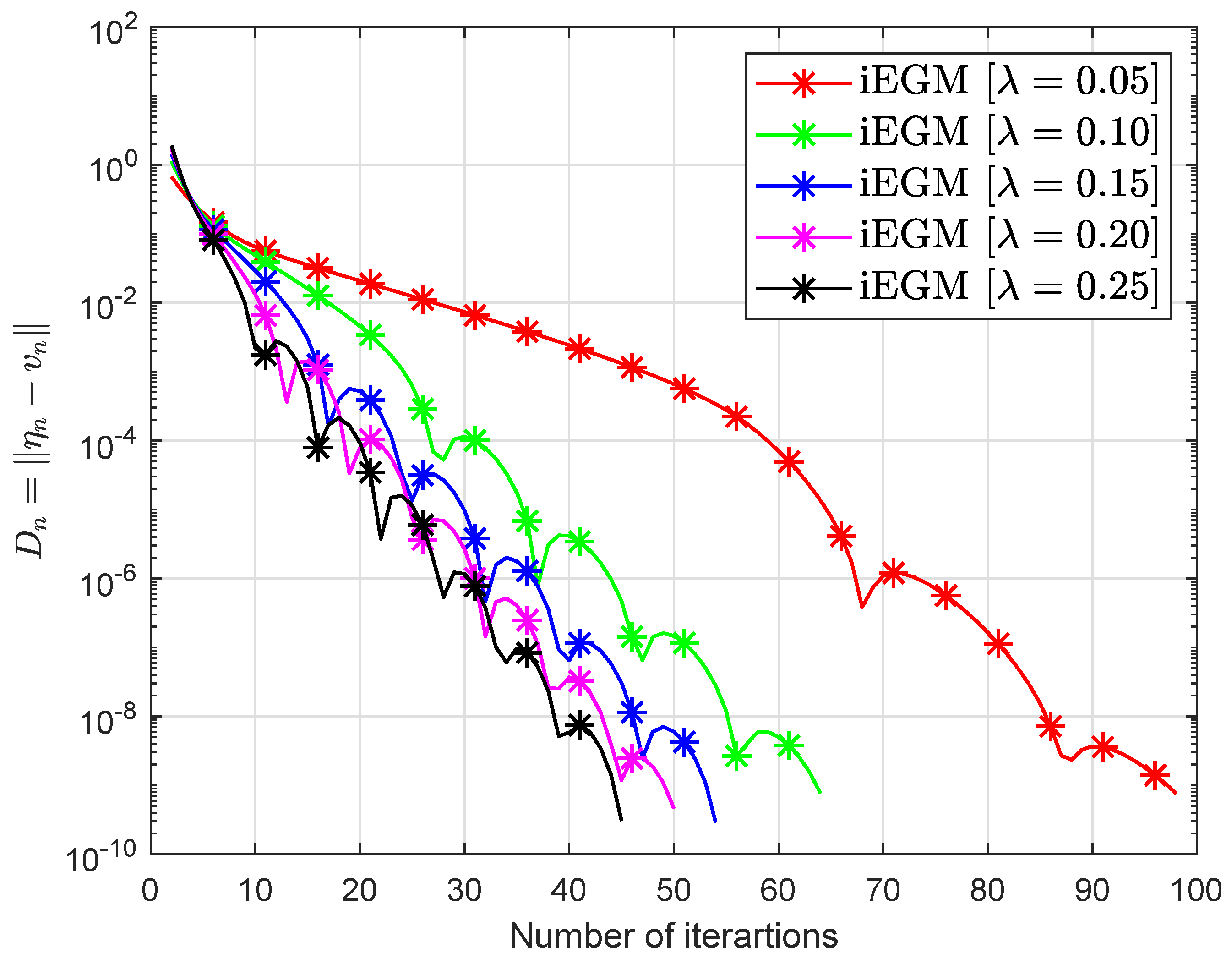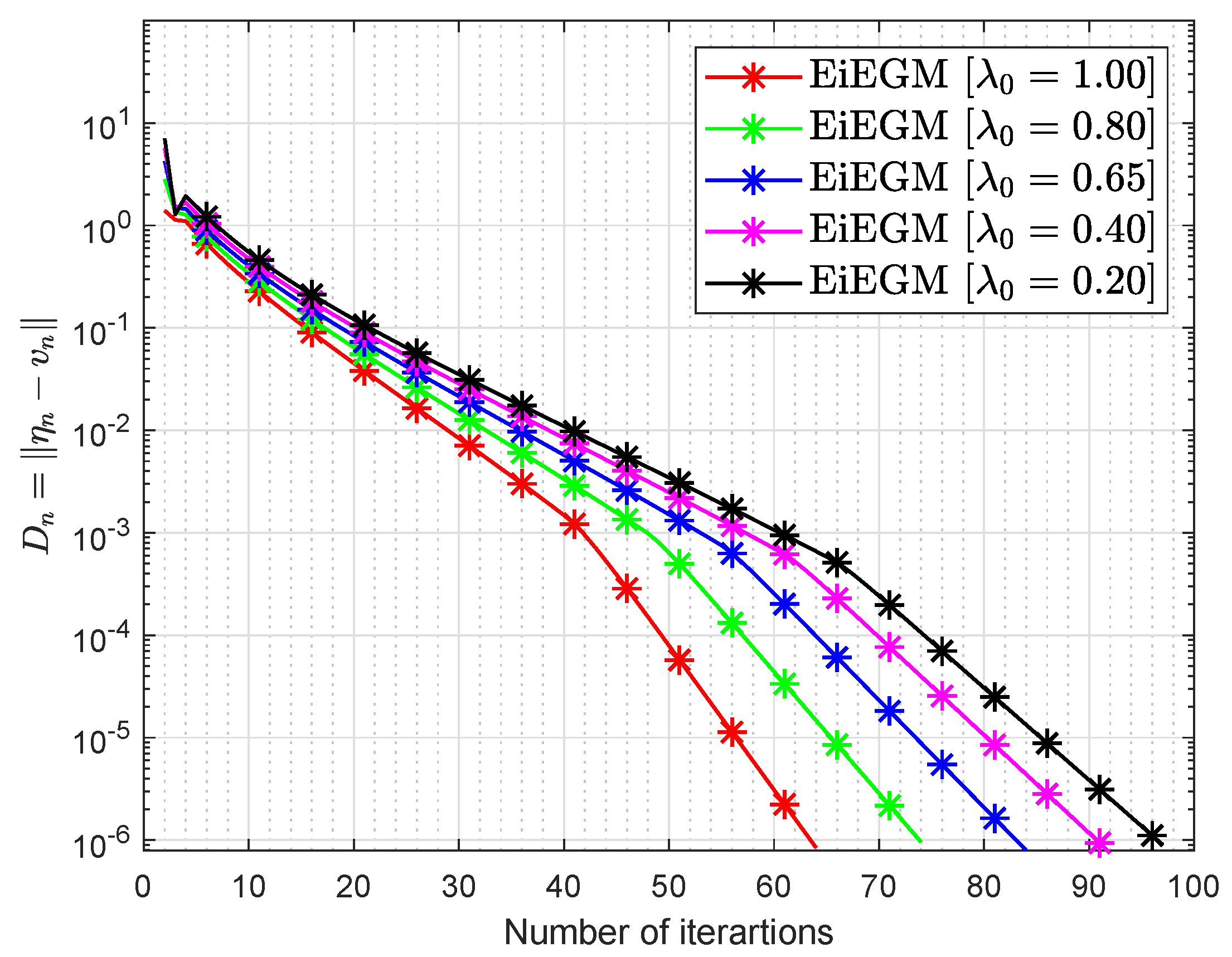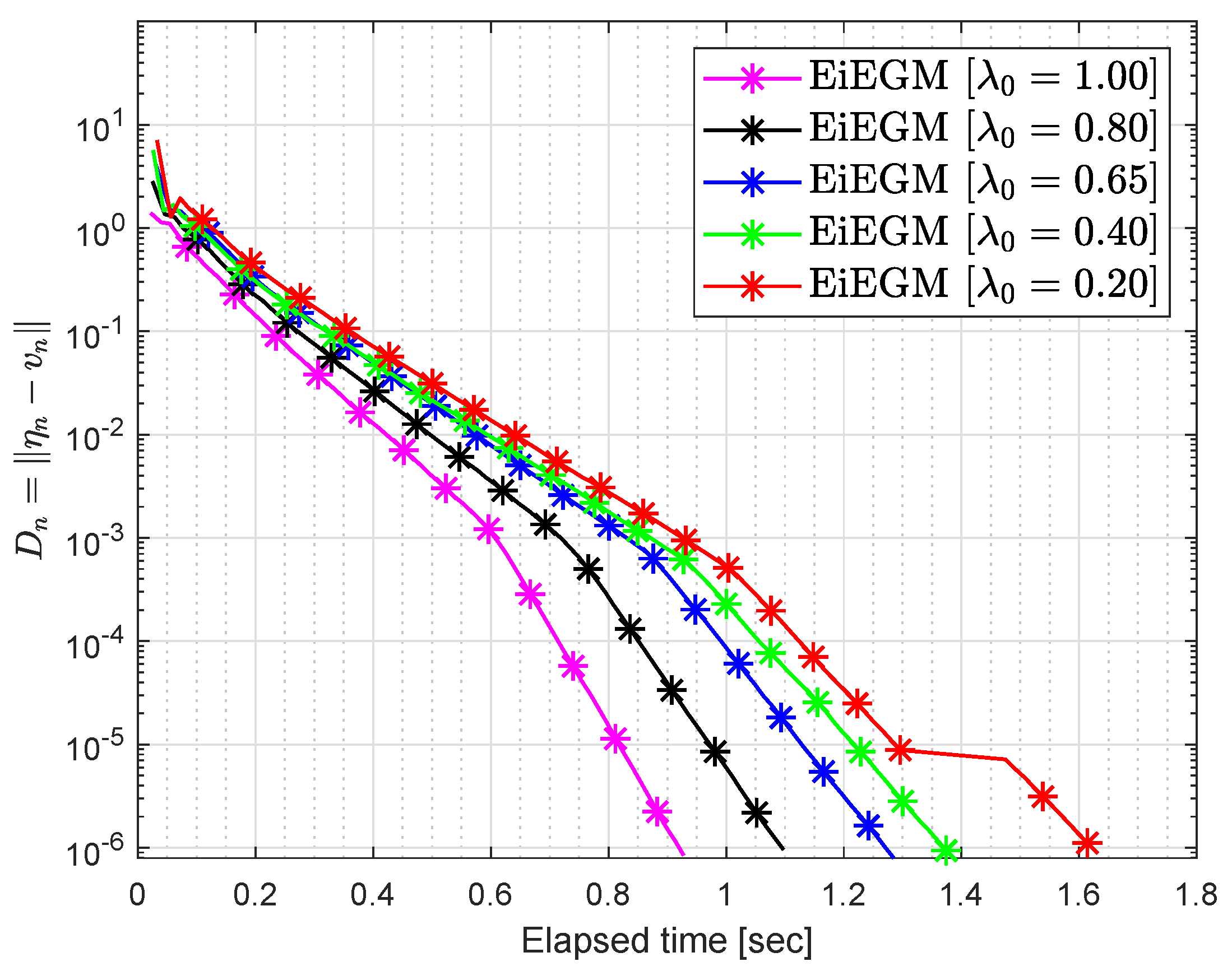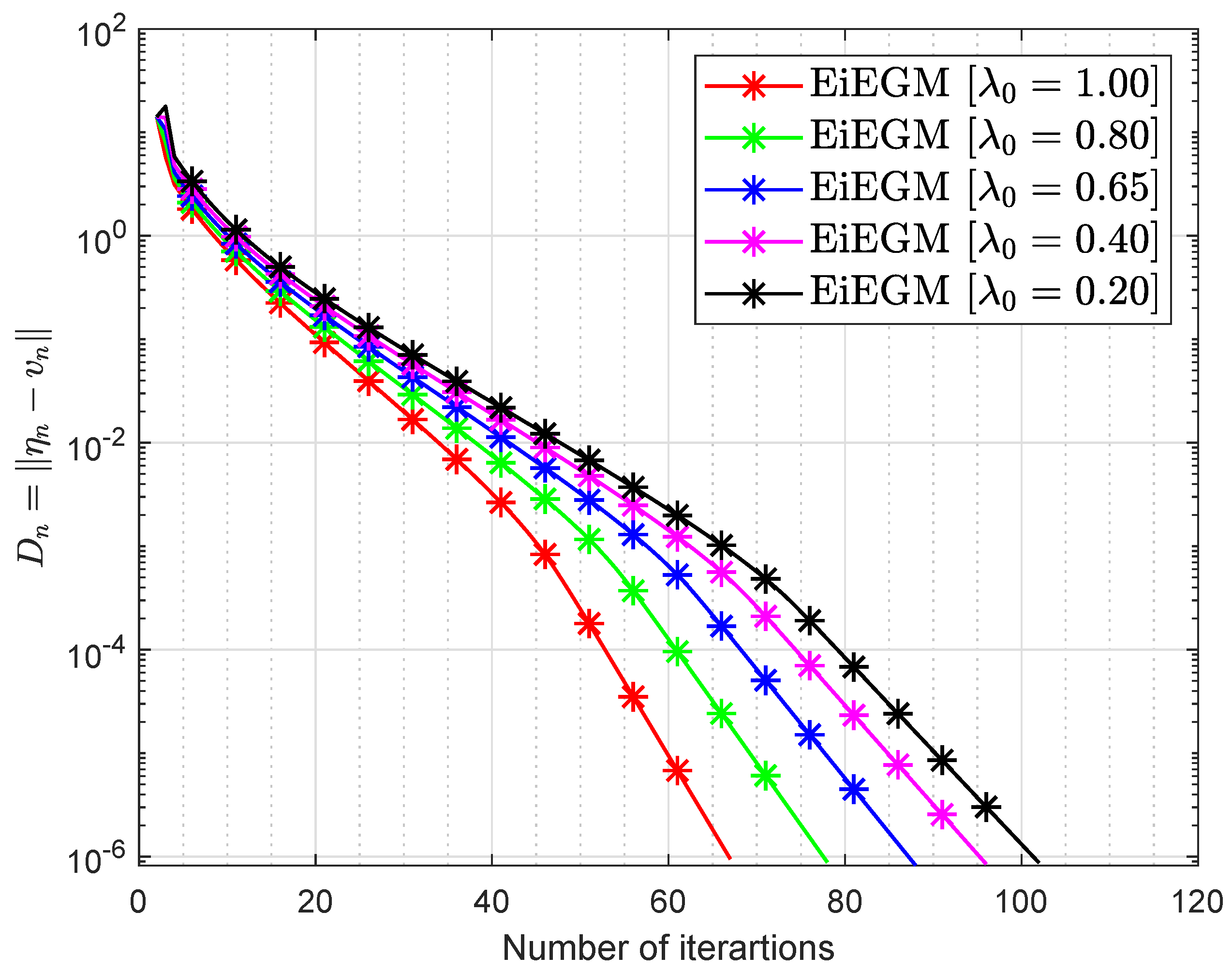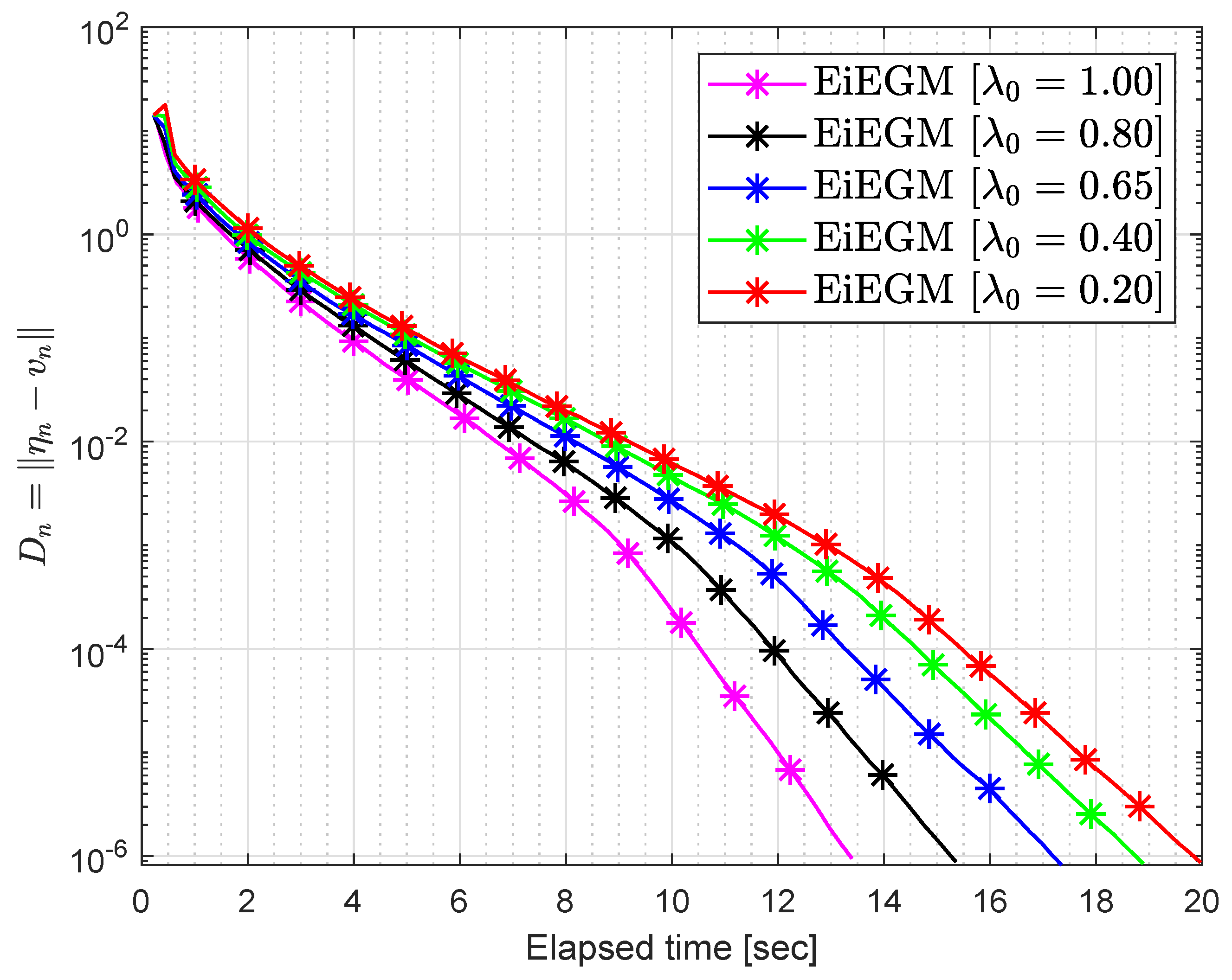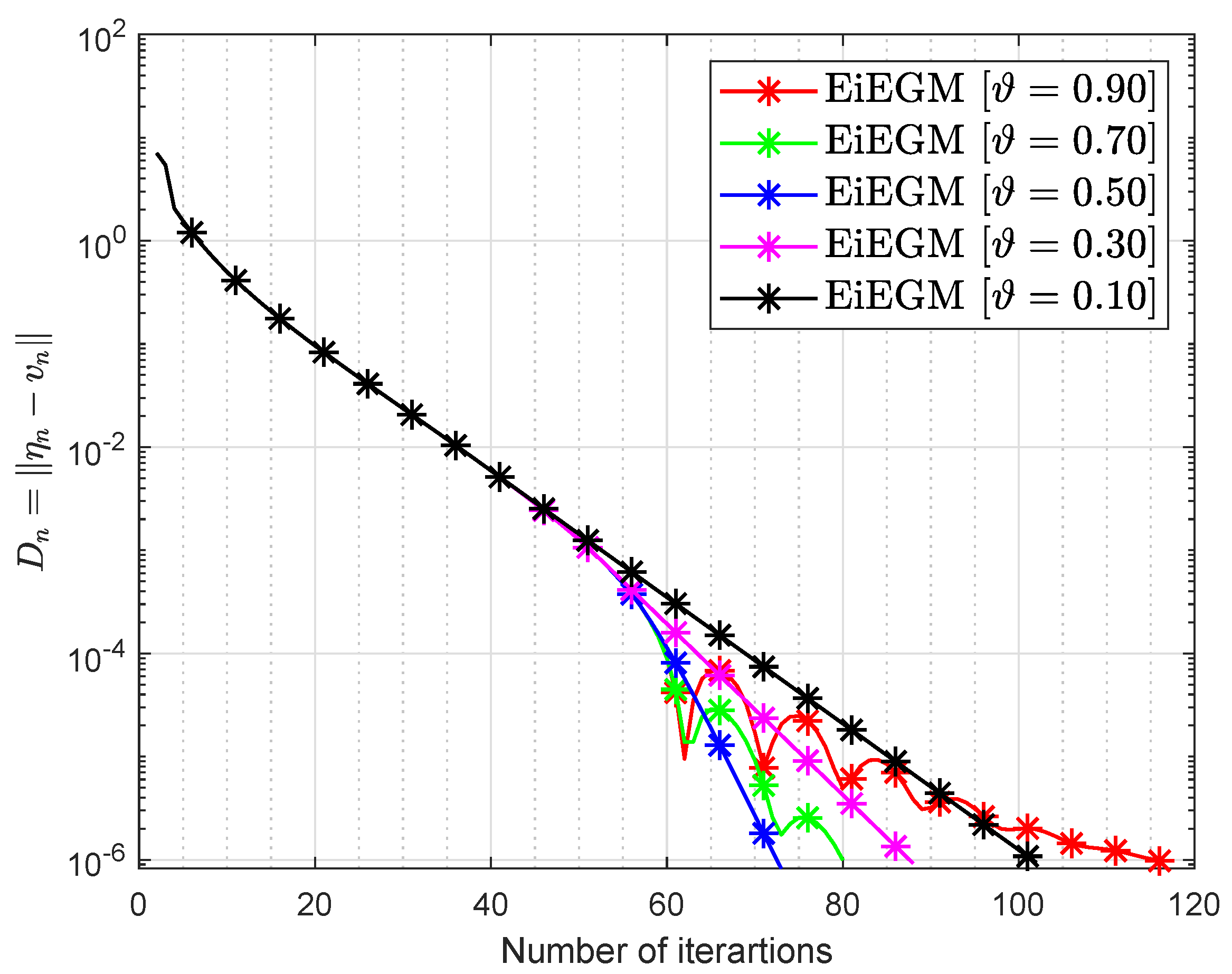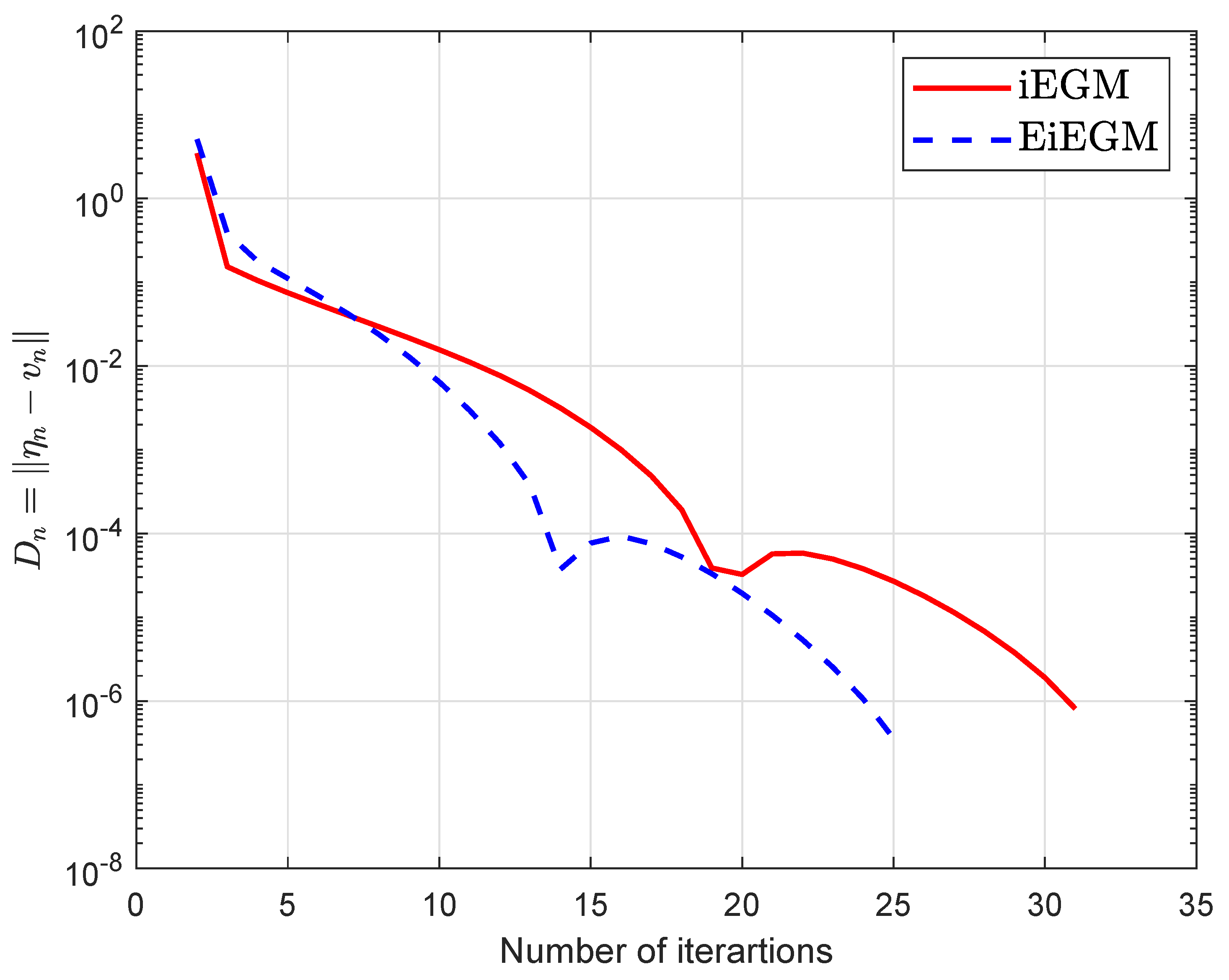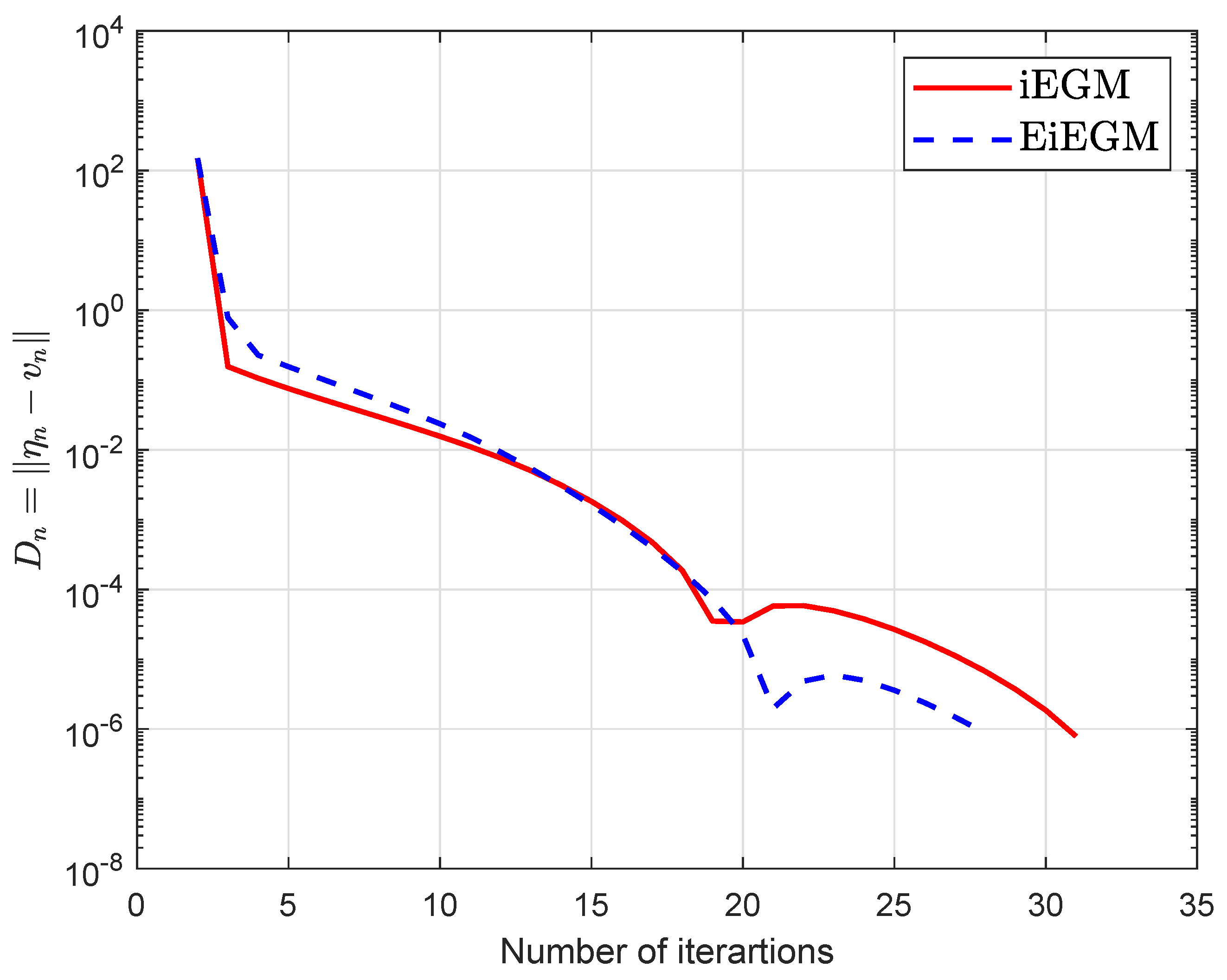1. Introduction
Let
be a nonempty, closed and convex subset of a real Hilbert space
and
be the sets of real numbers and natural numbers, respectively. Assume that
f is a bifunction
and
denotes the solution set of an equilibrium problem over the set
Now, consider the following definitions of a bifunction monotonicity (see [
1,
2] for more details). A function
on
for
is said to be:
- (1)
- (2)
- (3)
γ-strongly pseudomonotone if
- (4)
It is clear from the definitions mentioned above that they have the following consequences:
In general, the converses are not true. A bifunction
is said to be Lipschitz-type continuous on
if there exist two positive constants
such that
Let
be a nonempty closed convex subset of
and
be a bifunction with
for all
An
equilibrium problem [
1,
3] for
f on the set
is to
An equilibrium problem (
1) had many mathematical problems as a particular case, i.e., the variational inequality problems (VIP), optimization problems, fixed point problems, complementarity problems, the Nash equilibrium of non-cooperative games, saddle point problems and the vector optimization problem (for details see [
1,
4,
5]). The equilibrium problem is also known as the famous Ky Fan inequality [
3]. However, the particular format of an equilibrium problem (
1) was initiated by Muu and Oettli [
6] in 1992 and further investigation on its theoretical properties were provided by Blum and Oettli [
1]. The construction of new iterative schemes and the modification of existing methods, as well as the study their convergence analysis, constitute an important research direction in equilibrium problem theory. Several methods have been developed in the past few years to approximate the solution of an equilibrium problem in finite and infinite dimensional real Hilbert spaces, i.e., extragradient methods [
7,
8,
9,
10,
11,
12,
13,
14,
15,
16], subgradient methods [
17,
18,
19,
20,
21,
22], inertial methods [
23,
24,
25] and methods for particular classes of equilibrium problems [
26,
27,
28,
29,
30,
31,
32,
33,
34,
35].
In particular, a proximal method [
36] was used to solve equilibrium problems based on solving minimization problems. This approach was also known as the two-step extragradient-like method in [
7] due to the early contribution of the Korpelevich [
37] extragradient method to solve the saddle point problems. More precisely, Tran et al. introduced a method in [
7], and an iterative sequence
was generated as follows:
where
. The iterative sequence generated from the above-mentioned method provides a weak convergent iterative sequence and in order to operate it, prior information regarding the Lipschitz-type constants is required. These Lipschitz-type constants are mostly unknown or hard to compute. To overcome this situation, Hieu et al. [
14] introduced an extension of the method in [
38] for solving the equilibrium problem as follows: Let
and choose
with
such that
where the stepsize sequence
is updated in the following way:
Recently, Vinh and Muu proposed an inertial iterative algorithm in [
39] to solve a pseudomonotone equilibrium problem. Their main contribution is the availability of an inertial effect in the algorithm that is used to improve the convergence rate of the iterative sequence. The iterative sequence
has been generated in the following manner:
- (i)
Choose
while a sequence
is satisfying the following condition:
- (ii)
Choose
such that
where
- (iii)
This article focuses on projection methods that are well-known and easy to execute due to their efficient and straightforward mathematical computation. Motivated by the works of [
14,
40], we formulate an inertial explicit subgradient extragradient algorithm to solve the pseudomonotone equilibrium problem. The proposed algorithm can be seen as the modification of the methods that appear in [
7,
14,
39]. Under certain mild conditions, a weak convergence result has been proven to correspond to the iterative sequence of the algorithm. Moreover, experimental studies have shown that the proposed method tends to be more efficient compared to the existing method [
39].
The remainder of this paper is arranged as follows:
Section 2 contains some definitions and basic results used in the paper.
Section 3 contains our main algorithm and proves its convergence.
Section 4 and
Section 5 incorporate the implementation of our results.
Section 6 carries out the numerical results that demonstrates the computational effectiveness of our proposed algorithm.
3. Convergence Analysis for an Algorithm
We provide a method consisting of two strongly convex minimization problems through an inertial factor and an explicit stepsize formula, which are being used to improve the convergence rate of the iterative sequence and to make the method independent of the Lipschitz constants. The detailed method is provided below Algorithm 1:
| Algorithm 1 (Inertial methods for pseudomonotone equilibrium problems) |
Initialization: Choose and a sequence satisfying
Iterative steps: Choose satisfying and
Step 1: Determine
where If ; STOP. Otherwise, go to next step. Step 2: Determine a half-space
where and evaluate
Step 3: Set and evaluate
Set and go back to Iterative steps.
|
Lemma 5. The sequence is decreasing monotonically with a lower bound and converges to
Proof. From the definition of
we see that this sequence is monotone and non-increasing. It is given that
f satisfies the Lipschitz-type condition with constants
and
. Let
such that
The above implies that the sequence has a lower bound Moreover, there exists a real number such that □
Remark 1. Due to the summability of , Expression (5) implies that:which implies that: Lemma 6. Assume that a bifunction satisfies the conditions (f1)
–(f4)
. For each we have Proof. From the value of
we have
For some
there exists
such that
The above equality implies that
Since
it follows that
for all
Thus, we have
Further,
and due to the definition of subdifferential, we have
Combining Expressions (
9) and (
10), we obtain
From the definition of
we can write
Due to
, we have
By substituting
in the above expression, we have
Combining Expressions (
12) and (
13), we obtain
By substituting
in Expression (
11), we have
Since
, we have
From the pseudomonotonicity of bifunction
f, we obtain
Hence, it follows from Expression (
15) that
From the definition of
we obtain
From Expressions (
16) and (
17), we have
Combining Expressions (
14) and (
18), we obtain
We have the following formulas:
Combining the relations (
19)–(
21), we get
□
Theorem 1. Assume that a bifunction satisfies the conditions (f1)
–(f4)
and belongs to solution set Then, the sequences and generated by Algorithm 1 converge weakly to the solution of the problem (1). In addition, Proof. Since
there exists a fixed number
such that
Thus, there is a finite number
such that
From the definition of
in Algorithm 1, we have
Expression (
23) can be written as
From the definition of the
, we also have
Combining relations (23) and (27), we obtain
By using Lemma 4 with (7) and (28), we have
From Equality (
8), we have
By letting
in Expression (
24), we obtain
From Lemma 6 and Expression (25), we have
which further implies that (for
)
By letting
in (33), we obtain
By using the Cauchy inequality and Expression (34), we obtain
From Expressions (31) and (34), we also obtain
It follows from Expressions (29), (31), and (36) that the sequences
, and
are bounded. Next, we need to use Lemma 3, for it is compulsory to prove that all sequential weak cluster limit points of the sequence
belong to the solution set
Assume that
z is any weak cluster limit point of the sequence
, i.e., there exists a subsequence
of
such that
Since
it follows that
also weakly converges to
z and so
Now, it remains to prove that
By Expression (
11), the definition of
, and (
14), we have
where
It follows from (30), (34), (35), and the boundedness of
that the right hand side tends to zero. Due to
condition (f3), and
we have
Since it follows that This implies that Finally, from Lemma 3, the sequences , and converge weakly to as
Moreover, the renaming part consists of proving that
Let
For any
we have
The above expression implies that the sequence
is bounded. Next, we prove that
is a Cauchy sequence. By Lemma 1(iii) and (27), we have
Lemma 4 provides the existence of
From Expression (27) for all
we have
Suppose that
for
By using Lemma 1(i) and Expression (40), we have
The existence of
and the summability of the series
imply that
for all
As a result,
is a Cauchy sequence and due to the closeness of a solution set
the sequence
strongly converges to
Next, we show that
Due to Lemma 1(ii) and
we can write
Due to
and
we obtain
which gives that
□
4. Applications to Solve Fixed Point Problems
Now, consider the applications of our results from
Section 3 to solve fixed-point problems involving
-strict pseudo-contraction. A mapping
is said to be
- (i)
-strict pseudo-contraction [
45] on
if
which is equivalent to
- (ii)
sequentially weakly continuous on
if
The fixed point problem for a mapping
is formulated in the following way:
Note: If we define bifunction
Then, the equilibrium problem (
1) converts into the fixed point problem with
From the value of
in Algorithm 1, we have
Since
, it follows from the definition of the subdifferential that we have
and consequently
This implies that
Similarly to Expression (45), we obtain
As a consequence of the results in
Section 3, we have the following fixed point theorem:
Corollary 1. Let be a subset of a Hilbert space and be a κ-strict pseudocontraction and weakly continuous with The sequences , and are generated in the following way:
- (i)
Fix and with a sequence such that - (ii)
Choose such that and - (iii)
Evaluatewhere - (iv)
Set and revise the stepsize in the following way:
Then, sequences , and weakly converge to
5. Application to Solve Variational Inequality Problems
Now, consider the applications of our results from in
Section 3 to solve variational inequality problems involving a pseudomonotone and Lipschitz-type continuous operator. An operator
is said to be
- (i)
L-Lipschitz continuous on
if
- (ii)
The variational inequality problem for a operator
is formulated in the following way:
Note: If we define a bifunction
Thus, the equilibrium problem (
1) translates into a variational inequality problem with
From the value of
we have
Since
it follows from the subdifferential definition that we have
and consequently
This implies that
In similar way to Expression (52), we have
Suppose that K satisfies the following conditions:
- (K1)
K is pseudomonotone on with ;
- (K2)
K is L-Lipschitz continuous on with ;
- (K3)
and satisfying
Corollary 2. Assume that a operator satisfies the conditions (K1)–(K3) and that the sequences , and are generated in the following way:
- (i)
Choose and with such that - (ii)
Choose satisfying such that - (iii)
Set and computewhere - (iv)
Set and stepsize is revised in the following way:
Then, the sequences , and weakly converge to
